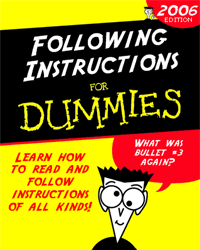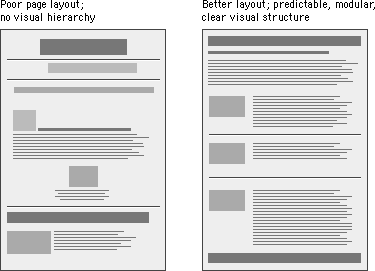The Top Six Tips on How to Be a Great Web Designer
I have a background as both a web and print designer (something I revisit occasionally to remember how much I don’t enjoy it). I have hired them and have managed them. A friend of mine complains about the lack of good designers in San Francisco, and I find the same things in other places.
I have a stack of about 2,000 resumes, and many of them fail at the basics — typography, composition, use of color. It’s even more frustrating, because I depend on good designers to get the results I want and am frequently disappointed in the outcome.
Anyone can open Photoshop, Illustrator or Dreamweaver, but it takes a good designer than can communicate and grow with clients. The reality is the most valuable designers are the one’s that understand the needs of the project first and are creative second.
Follow Instructions and Apply the Right Amount of Effort
 The hardest part about working with clients is communicating with them.
The hardest part about working with clients is communicating with them.
Words don’t adequately describe what we need to be designed, so designers and lay folk meet in this awkward common ground where the results are not so common.
When a designer meets someone that understands the craft, there is an importance to following instructions that is much higher than working with a normal client. Also, knowing what’s appropriate for a task (a ten hour logo versus a full branding exercise) is something that should be asked. Many clients are looking for the right amount of effort on a task and will pay for it.
So here’s a tip: sit down and draw out what the client or manager wants by sketching it on a piece of paper — even if it means getting a user experience designer involved. Then ask, “How much time should I spend on this? Is this a one hour task? One day task? One year task?”
You’ll be surprised at the clarifications you’ll get.
Learn to Adapt to Other Styles
The vast majority of work on the web is not designing new sites: it’s maintaining existing sites and designs. This means that if you are a designer, you’re going to be picking up the designs of someone who’s the art director or a previous designer on the project.
This is hard.
Unless you have a distinct design style that resonates (Saul Bass and Andy Warhol come to mind), you’re going to work in situations where there’s going to be either an Art Director or Creative Director that’s going to lay down the line before you.
This means that you have to copy other artists work, which is not necessarily a bad thing. You learn how to deconstruct other styles and, in the process, will probably improve your design skills. I think colleges and art institutes spend too much time on teaching students how to develop new designs and should spend more time teaching how to copy current designs to illustrate what makes them effective.
And seriously, do you think your own designs are all that original?
Copyists in the art world get paid well, and there’s a whole career called conservator that involves preserving and restoring artwork in its original form and intent, even if that form is missing. Learn how to replicate other styles. Not only will you learn, but it will keep you employed.
Don’t Be a Stay at Home Defenseman
 This is the hardest one, because creative folks are creative folks. This is the way I explain it: the NHL stay at home defensemen are slow, lumbering bruisers that work best on their end of the ice, disrupting and doing one thing: stopping the puck. However, when required to score, they don’t get much further than the blue line at the offensive end, because they are always trying to get back.
This is the hardest one, because creative folks are creative folks. This is the way I explain it: the NHL stay at home defensemen are slow, lumbering bruisers that work best on their end of the ice, disrupting and doing one thing: stopping the puck. However, when required to score, they don’t get much further than the blue line at the offensive end, because they are always trying to get back.
They also don’t take a lot of initiative — doing only what they know how to do. Designers are the same way.
In big corporate environments, having one skill can work, but when you’re in the real world, clients are going to ask for CSS skills or if you know a bit of Flash or can do some data entry into a content management system.
I don’t think designers have to know everything, but each skill that a designer has over “I can use Photoshop” is another skill to use when billing out to clients.
Learn Great Typography
No matter what someone says, typography is more important than ever on the web. Yet I see portfolio after portfolio where typography is average at best and poor at work. Love for typography goes well beyond knowing the difference between Tahoma and Arial or watching the movie Helvetica. Designers should know how to use type both to communicate and as an interface tool.
Here’s a challenge that will help any designer learn great typography: start with only Arial or Helvetica. Learn how to use contrasting weights and sizes to direct the users eye without using any other type styles.
I Love Typography has a great guide on how to use type on the web. They have the following quote:
First, it's worth noting that Typography is not just about choosing a font, or even distinguishing one typeface from another. In recent experiments, trained monkeys were able to correctly identify Helvetica 90% of the time.
Learn How to Design on a Grid and How to Use White Space
Grids are equally as important on the web as in any medium. The truth is that most designs are closer to mathematical equations than something overly creative and have to use white space and composition to: a) fit in a lot of content, b) be engaging with a call of action and c) look good. Not as easy as it looks.
Designing on a grid helps solve a lot of these issues without a lot of thought, and grids can also be used to establish design styles and visual structures.
Do Stuff No One Wants to Do
There’s nothing worse for a client or a manager to hear than having someone who says, “That’s something I don’t do,” especially when it falls right in the middle of their skill set and when they are junior to other designers and workers in that group.
Data entry. Sure.
Picking up work someone else is doing, but too busy to complete? Sure.
Doing production work to resize 70 logos to the right size? When do you need it?
Web design isn’t all glamour and glitz (how glamourous can a home page be?), and it isn’t all redesigning websites for the clients. Sometimes we have to remember it’s a job. Sometimes you’re just going to be changing the oil, but you’re still getting paid for it.
$99 Tough Love Resume and Portfolio Review
Tough love. Great Advice. Receive an one hour portfolio review and career coaching session online, or in person if you're in Seattle.

